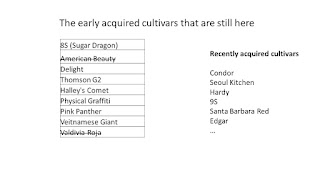Listing here my earliest mandarins that were ready in November of 2018.
The first mandarin we started to eat already in October was Myagawa Satsuma, and the fruits became sweeter in November. By the mid-November, Primorosa mandarin, Miho Wase Satsuma, and Corsica #2 mandarin were ready. S9 satsuma ripened by the end of November.
The first mandarin we started to eat already in October was Myagawa Satsuma, and the fruits became sweeter in November. By the mid-November, Primorosa mandarin, Miho Wase Satsuma, and Corsica #2 mandarin were ready. S9 satsuma ripened by the end of November.
Left to right here: Myagawa, Primorosa, Miho Wase, Corsica #2.
Indiomandarinquat is on top (not ready in November)
S9 satsuma
They are about the same size as Miho Wase.









































































